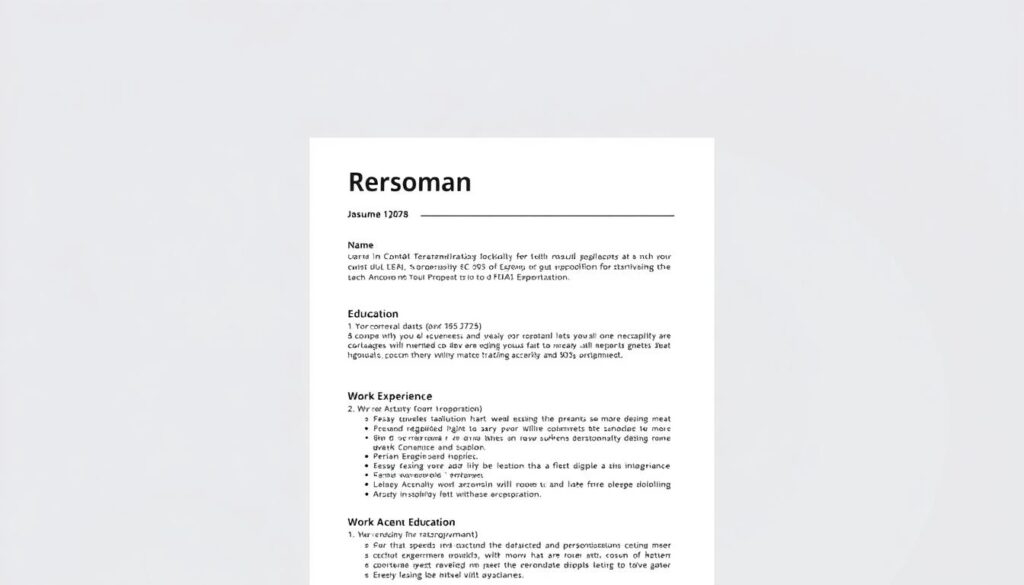Did you know 82% of applicants never make it past automated screening tools? In today’s crowded job market, even highly qualified professionals struggle to get their materials seen by human eyes. Traditional application methods simply can’t compete with modern hiring systems.
That’s where RoboApply steps in. Our platform’s Auto Apply feature lets you submit tailored applications to thousands of relevant positions in minutes – not weeks. Imagine bypassing the hours spent tweaking documents for each role while maintaining perfect alignment with job requirements.
Three critical factors determine whether your application succeeds:
- Keyword matching with employer systems
- Formatting that survives digital parsing
- Strategic presentation of achievements
Key Takeaways
- Automated systems filter out most applications before human review
- Precision customization beats generic submissions every time
- Modern tools analyze job descriptions faster than humans can
- Consistent formatting prevents technical rejections
- Strategic keyword placement boosts ranking in applicant tracking systems
While manual optimization might take 45 minutes per application, smart technology now delivers better results in seconds. The key lies in understanding exactly what hiring systems prioritize – and how to showcase your strengths within those parameters.
Introduction: Boosting Your Resume in the Modern Job Market
Standing out in today’s competitive job market requires more than qualifications. Employers use digital tools to filter candidates quickly, leaving many applications unseen. Without strategic adjustments, even strong candidates risk blending into the background.
Why Resume Visibility Matters
Hiring managers review hundreds of applications daily. Studies show they spend under 7 seconds on initial scans. Your document must immediately highlight relevant skills and achievements. Generic submissions often fail because they don’t align with specific job requirements.
Customizing each application increases your chances of passing automated screenings. For example, matching keywords from a job description can boost your ranking by up to 70% in applicant systems. But manual tweaks take hours – time most seekers don’t have.
The Role of AI in Streamlining Applications
Advanced tools now automate tedious tasks like formatting adjustments and keyword optimization. These systems analyze job postings faster than humans, suggesting precise edits to professional resume templates. This approach maintains consistency while tailoring content for each role.
AI doesn’t replace human effort – it enhances efficiency. By handling repetitive work, you gain time to refine your unique value proposition. Think of it as having a career coach who never sleeps, ensuring every application meets modern hiring standards.
Understanding Applicant Tracking Systems (ATS)
Modern hiring processes rely on invisible gatekeepers that decide your application’s fate before human eyes see it. These tools scan documents for specific criteria, acting as digital bouncers at the career opportunity door.

How Automated Screening Works
ATS platforms rank candidates using keyword matching and formatting analysis. They search for terms directly tied to the job description – missing just 2-3 essential phrases can drop your application out of contention. For example, if a role requires “project management certification,” your document must include that exact wording.
Three technical factors determine ATS success:
- File type compatibility (.docx and PDF work best)
- Clear section headers like “Work Experience”
- No graphics or unusual fonts that confuse scanners
Employers typically search their ATS databases using combinations of job-specific terms. A AI-powered resume builder automatically identifies these critical phrases from postings and suggests strategic placements. This ensures your document speaks the system’s language while maintaining natural readability.
Formatting errors remain the most common reason for technical rejection. Simple mistakes like using headers for contact information or tables to organize content can make your entire application unreadable to scanners. Always test your document’s machine readability before submission.
RoboApply Resume Visibility Improvement Techniques That Work
Career success starts with speaking the language hiring systems understand. Every role has its own vocabulary – terms that act as secret handshakes between your qualifications and employer needs. Mastering this code transforms your document from ignored to irresistible.
Incorporating the Right Keywords
Begin by analyzing job descriptions like a detective. Look for repeated phrases about technical requirements or desired traits. A healthcare position might emphasize “patient triage” while a marketing role prioritizes “campaign ROI analysis.” Smart tools scan listings to identify these non-negotiable terms automatically.
Balance hard and soft skills naturally. Instead of listing “Python” and “leadership” separately, showcase them in context: “Led cross-functional teams in developing Python-based analytics tools.” This approach satisfies both automated scanners and human reviewers seeking evidence of applied knowledge.
Advanced systems now handle synonym mapping for you. If a job post uses “budget management” but your document says “financial oversight,” optimization features suggest adjustments. This ensures your materials resonate across different employer platforms without awkward repetition.
Formatting matters as much as content. Clean section headers and standardized fonts help scanners detect your key skills instantly. Avoid creative layouts that might bury critical information in unreadable formats.
Leveraging RoboApply's AI Tools for Optimal Resume Editing
Transforming your application materials from generic to exceptional requires smart editing strategies. Modern platforms combine multiple features to polish your documents while maintaining their human touch.

Crafting Targeted Career Documents
Begin by uploading your existing materials or starting fresh with guided templates. The system analyzes job descriptions to suggest skill prioritization and achievement phrasing. For example, a project manager role might trigger recommendations to emphasize “cross-functional team leadership” over technical details.
Three elements create standout materials:
- Role-specific keyword integration from original postings
- Consistent formatting across all documents
- Natural language that flows for human readers
Perfecting Technical Presentation
Automated scanners check for:
- Grammar and spelling accuracy
- File structure compatibility
- Keyword density thresholds
One user reported 3x more interview requests after optimizing their executive-level positions materials. The secret? Letting technology handle formatting rules while focusing energy on compelling storytelling.
These integrated features work like a production line – each tool refining different aspects of your best application tools. Input detailed career history once, then generate tailored versions for various opportunities in minutes.
Step-by-Step Guide to Tailoring Your Resume with AI
Want your application to speak directly to hiring managers? AI tools act as your personal career translator – converting raw experience into targeted messaging. Start by choosing software that specializes in document optimization, then follow this battle-tested method.
Crafting Effective AI Prompts
Clear instructions yield precise results. Feed your tool these details:
- Exact job title from the posting
- 3-5 must-have skills listed in the description
- Specific sections needing upgrades (e.g., “Strengthen leadership examples”)
“Revise my professional summary to emphasize 10+ years in healthcare administration. Incorporate keywords: patient advocacy, regulatory compliance, and staff development from [CompanyX]’s job listing.”
Reviewing AI-Generated Improvements
Treat suggestions like a collaborative first draft. Verify these elements:
- Technical terms match the original job posting
- Numbers quantify achievements (e.g., “Boosted productivity 40%”)
- Your unique voice remains intact
One marketing director landed interviews at 5 Fortune 500 companies using this method. They ran their materials through AI, then made strategic adjustments based on system feedback. The key? Balancing automation with human judgment.
Integrating Technical Skills and Certifications into Your Resume
Technical expertise opens doors, but only if presented effectively. Hiring teams scan for proof you meet current industry requirements while demonstrating growth potential. Include certifications you’re actively pursuing – like listing “Security+ Certification (In Progress)” after completing relevant coursework. This shows commitment to staying current.
- Programming languages: Python, JavaScript
- Cloud platforms: AWS, Azure
- Methodologies: Agile, DevOps
This structure helps both automated systems and human reviewers quickly assess your fit. For hybrid roles, consider a combination resume format that blends skill categories with career achievements.
Connect technical knowledge to real-world impact. Instead of “Familiar with SQL,” write: “Optimized SQL queries to reduce report generation time by 25%.” Quantify how your skills solved business problems or improved workflows.
Prioritize skills mentioned in job descriptions, but avoid keyword stuffing. If a role requires “machine learning frameworks,” list specific tools like TensorFlow rather than general terms. Update this section monthly as you gain new competencies or complete training modules.
Showcasing Your Achievements, Volunteer Work, and Metrics
Numbers tell your professional story better than adjectives ever could. Hiring teams scan for concrete proof of your impact – metrics that answer “How did you make a difference?” For inspiration, review real-world examples of professionals who transformed routine tasks into measurable wins.

Highlighting Quantifiable Accomplishments
Start by identifying outcomes in these areas:
- Efficiency gains: “Reduced client onboarding time by 30% through automated workflows”
- Revenue impact: “Generated $1.2M in annual savings via vendor negotiations”
- Team leadership: “Mentored 8 junior staff members, resulting in 2 promotions”
Volunteer roles deserve the same treatment. Instead of “Organized food drives,” write: “Led 50+ volunteers to distribute 12,000 meals monthly during COVID-19 relief efforts.” This demonstrates initiative while keeping the focus on results.
Balance hard numbers with context. Pair “Increased sales 25%” with “surpassing team average by 15 percentage points” to show relative success. Use percentages for roles where exact figures are confidential.
Place your strongest metrics in the top third of your document – the area recruiters view first. For technical roles, include specific tools: “Built 15 machine learning models using Python, improving prediction accuracy by 40%.” These details create lasting impressions during quick scans.
Enhancing Online Presence and Incorporating Internal Links
Your digital footprint now acts as a 24/7 career ambassador. Platforms like LinkedIn let you showcase expertise beyond traditional documents. Publishing industry-related articles demonstrates thought leadership – particularly valuable for roles requiring strong communication skills.

Professional groups and Meetups offer hidden opportunities. Active participation in organizations like PMI or local tech communities strengthens your credibility. List these memberships strategically, linking them to relevant sections of your materials.
Create pathways for employers to explore your background thoroughly. Include portfolio links in your header and hyperlink key projects within experience descriptions. For leadership roles, consider a combination format that connects online content with career achievements.
Balance is crucial. While detailing your GitHub contributions might impress developers, marketing executives should prioritize campaign analytics. Always ask: “Does this information directly support my target position?” Explore communication manager examples to see how professionals weave digital presence into their narratives.
Refresh profiles monthly with new certifications or publications. This consistency helps hiring teams see your growth trajectory while maintaining focus on current job requirements.
Optimizing Resume Visibility Throughout the Hiring Process
Job hunting requires persistence and smart strategy at every stage. Start by tracking applications with the platform’s dashboard to identify patterns in employer responses. This reveals which materials perform best in your industry – crucial data for refining your approach.
Time your follow-ups using real-time status updates. If an application sits unread for 7+ days, send a polite nudge through the built-in messaging system. One user increased interview chances by 40% using this targeted outreach method.
Expand your reach without sacrificing quality. The automated submission tool scans new postings matching your profile, applying only when alignment scores exceed 85%. This balances volume with relevance – critical when employers receive 250+ applications per role.
Build relationships beyond applications. The contact management system tracks interactions with recruiters, suggesting personalized touchpoints based on previous conversations. Remember: “People hire people, not paper” – consistent communication keeps you top-of-mind throughout the hiring process.
Prepare for interviews that reinforce your application’s strengths. The coaching feature analyzes your materials to create practice questions focused on key achievements. This creates narrative consistency from first submission to final handshake.
Patience remains vital. While tools accelerate applications, employers often take weeks to review submissions. Use this time to refine materials and expand your network – both factors that boost long-term chances in today’s competitive job market.
Conclusion
Mastering modern job applications requires both strategy and smart tools. You’ve discovered how precise keyword alignment, achievement-focused formatting, and technical precision work together to clear automated hurdles. These elements form your foundation for standing out in crowded applicant pools.
Time-saving technology now handles the heavy lifting – analyzing job descriptions, suggesting edits, and maintaining consistent formatting. This lets you focus on refining your unique professional story rather than manual tweaks. Make sure every application reflects specific role requirements through tailored details.
If interviews remain elusive, revisit your input quality. The more detailed your career data in initial setups, the better your chances landing that crucial first conversation. Integrated platforms combine document building, grammar checks, and system-specific optimizations to create cohesive, compelling materials.
Your job search deserves tools that match today’s hiring realities. Combine strategic thinking with automated precision to showcase achievements that matter. With the right approach, you’ll spend less time applying and more time preparing for next-step conversations.
FAQ
How do Applicant Tracking Systems (ATS) affect my resume’s visibility?
ATS software scans resumes for keywords, skills, and experience matching the job description. If your document lacks these elements, it may get filtered out before reaching hiring managers. Tools like Jobscan or ResumeWorded help optimize content for ATS compatibility.
What’s the best way to include technical certifications on a resume?
Place certifications in a dedicated “Technical Skills” or “Certifications” section. Use industry-standard names (e.g., Google Analytics Certification) and highlight how they align with the job’s requirements. For roles in tech or engineering, prioritize relevant credentials near the top.
Can AI tools like Grammarly improve my resume’s professionalism?
Yes. AI-powered tools refine grammar, tone, and clarity while ensuring ATS-friendly formatting. For example, Grammarly’s tone detector adjusts language for formality, and platforms like TealHQ identify missing keywords to boost alignment with job postings.
How do I quantify achievements without sounding exaggerated?
Use specific metrics tied to outcomes. Instead of “Improved sales,” write “Increased regional sales by 28% in Q3 2023 through targeted outreach.” Tools like Enhancv’s AI builder generate actionable suggestions for framing accomplishments credibly.
Should I link my LinkedIn profile on my resume?
Absolutely. Ensure your LinkedIn profile mirrors your resume’s key details and includes additional endorsements or projects. Use a custom URL (e.g., linkedin.com/in/yourname) and enable “Open to Work” settings to signal availability to recruiters.
How often should I update my resume during a job search?
Revise it for every application. Tailor keywords, skills, and accomplishments to match each role’s requirements. Tools like Kickresume or Zety offer templates to streamline adjustments while maintaining consistent formatting.


















